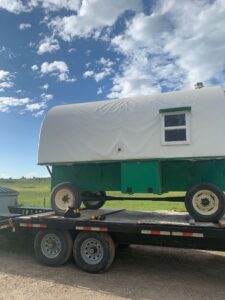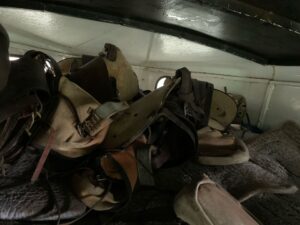Hitting Peak Season
#bfrdpwy #aginternship #RightRisk

As the halfway mark came and passed, this week has not really even registered to me. It was a very busy and fast-paced blur of the days. With the season officially kicking off at the ranch, this week was all mainly having all of the wranglers together to finish up orientation, pack checking and maintaining ranch vehicles, doing some more shoeing for the first large chunk of horses that would be brought to the upper ranch, and doing last rounds of weeding throughout hay pastures before we begin haying.
Some of the most significant learning points I took away from this week were on how to properly load and secure trailers, whether it be a flatbed trailer holding a sheep wagon or a horse trailer filled with hay, horses, or a myriad of gear. Knowing a few practical knots can help endlessly in situations like this. I also gained more information about weeds and the types, environments they thrive in, and how often they bloom or seed. Being able to help Jim to finish the horses for this round of shoeing was a great experience; I also was able to be more involved in the process compared to when farriers would come to do large portions of horses.

While there was a lot of great information that I was able to absorb and question, some of the biggest things that I would possibly challenge would focus largely on something that is never really in our control. Weather is something that can greatly impact farmers’ incomes and outputs and it was obvious how true that is this week. While we had planned to spend the majority of our time this week spraying weeds and looking over fields to make sure they were drying properly before haying begins, a mix of heavy rain, hail, and spotty sun all led our plans askew. Spraying weeds in the rain isn’t a possibility. When the rain comes at inopportune times it throws the ideal timeline off in order to compensate for how the weather has affected crops. My thought process when it comes to situations largely depending on the weather would be to have two possible plans to go through with. One is solely contingent on if there is ideal weather and would be able to go through with no hitches as long as the weather isn’t interfering. Another plan would consist of projects that could still go take place even in inclement weather. Having the option of a backup course of action would allow us to be able to stay productive and consistent.

A few of the questions that I am still unable to answer myself pertain to ranch vehicle maintenance and how to accommodate plans falling through. With as many ranch vehicles as this ranch has, one of my biggest questions is how large the necessity for all of them is and is there a possibility of having fewer vehicles that can have a larger focus and dedication to a better option? We also had one of the farriers that we call on to work on the horses say that he would no longer be working with us. This was very sudden and caused us to have to make some last-minute adjustments to plans and shoe a small number of horses ourselves. My question here would be what is the best course of action when someone whom you have done business with for so long decides to end that professional relationship? Could there possibly be a solution met that both parties agree is beneficial to everyone involved? I was also curious about how finding a new farrier would go, especially since there is such a large number of horses and mules that need to be shoed throughout the year. Finding someone who is consistent, efficient, and available seems to be a large factor going forward.
Moving into next week I feel more secure in my own abilities to recognize a number of weeds that we can see in our pastures during several phases of growth. I also feel more confident in my ability to do basic preventative maintenance on diesel and gas vehicles. Another thing that I can say is I now have a general understanding on is shoeing horses and doing very basic upkeep on shod horses. I have also gained an understanding of how to load the nose of a trailer efficiently and in a compact manner. Going forward I intend to be able to tell when certain pastures are dry enough to begin haying, along with being able to identify key signs that show how much time there is to get these pastures done before the crops start to die.
Submitted by: Olivia Halter
Edits by: GrowinG Internship Team

